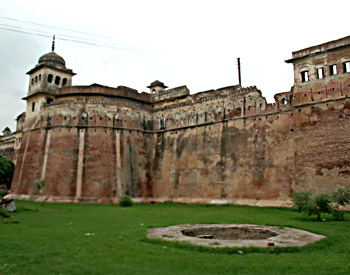 Androon Fort is that portion of Qila Mubarak palace that was inhabited by the members of Patiala dynasty. The entrance is through an imposing gate. The architectural style of this palace is a synthesis of late Mughal and Rajasthani styles. The complex has 10 courtyards along the north - south axis and each courtyard is unique in size and character, some being broad, others very small and still others mere slits in the fabric of building. Though Androon is a single interconnected building, it is spoken of as a series of palaces. Each set of rooms makes a cluster around a courtyard, and each carries a name: Sheesh Mahal, Toshakhana, Jalau Khana, Chand Mahal, Rang Mahal, treasury and prison. Ten of the rooms are painted with frescoes, or decorated intricately with mirror and gilt.
Androon Fort is that portion of Qila Mubarak palace that was inhabited by the members of Patiala dynasty. The entrance is through an imposing gate. The architectural style of this palace is a synthesis of late Mughal and Rajasthani styles. The complex has 10 courtyards along the north - south axis and each courtyard is unique in size and character, some being broad, others very small and still others mere slits in the fabric of building. Though Androon is a single interconnected building, it is spoken of as a series of palaces. Each set of rooms makes a cluster around a courtyard, and each carries a name: Sheesh Mahal, Toshakhana, Jalau Khana, Chand Mahal, Rang Mahal, treasury and prison. Ten of the rooms are painted with frescoes, or decorated intricately with mirror and gilt.
Further, in a tiny portion of Androon Fort is a little British construction with Gothic arches, fire places made of marble and built-in toilets perched on Mughal Rajasthani roof. Ran-Baas was probably a guest house. It has an imposing gateway and two courtyards, both with fountains and small tanks. A room in the first courtyard with painted walls and a gilt throne was probably for semi formal audience. A few pavilions are set among painted walls on the upper storey. Facing each other across the courtyard are two exquisite chambers, one painted and the other decorated with mirror work. Rang Mahal and Sheesh Mahal contain a large number of frescoes, most of which were made under Maharaja Narender Singh. The frescoes, among the finest painted in India in the second half of the 19th century are evidently the work of artists from Rajasthani, Pahari and Avadhi traditions.
Darbar Hall or Divan Khana of Androon Fort was used for large audiences and important public occasions. Presently, the Darbar hall has been converted into a museum displaying dazzling chandeliers and armor, including the sword and dagger of Guru Gobind Singh and Nadir Shah`s sword. The hall was built on a high platform over a network of tunnels which were service conduits. The facade gives the impression of a double-storey building, with `upper storey` windows and a balcony at the first floor level, but the delicately worked wood-and-glass doors open into a huge 15 metre high chamber. At the far end is a raised platform, which was used by the Maharajas. The wooden frame work of the ceiling holds decorated tiles painted in Arabic style and the ceiling is hung with a fabled collection of chandeliers.
Jalau Khana and Sard Khana (Cool Room) were much later constructions. The Jalau Khana is a small building with a central hall in late Colonial style, where regalia were displayed. The Sard Khana provided relief from the summer heat. A deep well inside it acted as a wind tunnel, bringing cool air into the ground-floor rooms and the basement. Outside, there is a garden with waterways and fountains. Another small building with a central courtyard and a well is the Lassi Khana or the kitchen. It adjoins the Ran-Baas, and a passage links it to the Qila Androon.



















